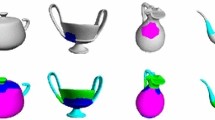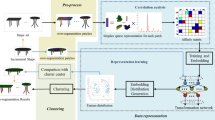Abstract
Co-analyzing a set of 3D shapes is a challenging task considering a large geometrical variability of the shapes. To address this challenge, this paper proposes a new automatic 3D shape co-segmentation algorithm by using spectral graph method. Our method firstly represents input shapes as a set of weighted graphs and extracts multiple geometric features to measure the similarities of faces in each individual shape. Secondly all graphs are embedded into the spectral domain to find meaningful correspondences across the set. After that we build a joint weighted matrix for the graph set and then apply normalized cut criterion to find optimal co-segmentation of the input shapes. Finally we evaluate our approach on different categories of 3D shapes, and the experimental results demonstrate that our method can accurately co-segment a wide variety of shapes, which may have different poses and significant topology changes.
Similar content being viewed by others
References
Attene M, Katz S, Mortara M et al. Mesh segmentation — A comparative study. In Proc. the IEEE International Conference on Shape Modeling and Applications, June 2006.
Katz S, Tal A. Hierarchical mesh decomposition using fuzzy clustering and cuts. ACM Transactions on Graphics, 2003, 22(3): 954–961.
Katz S, Leifman G, Tal A. Mesh segmentation using feature point and core extraction. The Visual Computer, 2005, 21(8/10): 649–658.
Agathos A, Pratikakis I, Perantonis S, Sapidis N. Protrusion- oriented 3D mesh segmentation. The Visual Computer, 2010, 26(1): 63–81.
Liu R, Zhang H. Mesh segmentation via spectral embedding and contour analysis. Computer Graphics Forum, 2007, 26(3): 385–394.
Shapira L, Shamir A, Cohen-Or D. Consistent mesh partitioning and skeletonisation using the shape diameter function. The Visual Computer, 2008, 24(4): 249–259.
Golovinskiy A, Funkhouser T. Randomized cuts for 3D mesh analysis. ACM Transactions on Graphics, 2008, 27(5): Article No.145.
Kalogerakis E, Hertzmann A, Singh K. Learning 3D mesh segmentation and labeling. ACM Transactions on Graphics, 2010, 29(4): Article No.102.
Golovinskiy A, Funkhouser T. Consistent segmentation of 3D models. Computers & Graphics, 2009, 33(3): 262–269.
Sidi O, van Kaick O, Kleiman Y, Zhang H, Cohen-Or D. Un-supervised co-segmentation of a set of shapes via descriptor-space spectral clustering. ACM Transactions on Graphics, 2011, 30(6): Article No.126.
Huang Q, Koltun V, Guibas L. Joint shape segmentation with linear programming. ACM Transactions on Graphics, 2011, 30(6): Article No.125.
Meng M, Xia J, Luo J, He Y. Unsupervised co-segmentation for 3D shapes using iterative multi-label optimization. Computer-Aided Design, 2013, 45(2): 312–320.
Hu R, Fan L, Liu L. Co-segmentation of 3D shapes via sub-space clustering. Computer Graphics Forum, 2012, 31(5): 1703–1713.
Rother C, Minka T, Blake A, Kolmogorov V. Cosegmentation of image pairs by histogram matching-incorporating a global constraint into MRFs. In Proc. the IEEE International Conference on Computer Vision and Pattern Recognition, July 2006, pp.993-1000.
Hochbaum D, Singh V. An efficient algorithm for co-segmentation. In Proc. the 12th IEEE Int. Conf. Computer Vision, Sept. 29-Oct. 2, 2009, pp.269-276.
Toshev A, Shi J, Daniilidis K. Image matching via saliency region correspondences. In Proc. the IEEE Int. Conf. Computer Vision and Pattern Recognition, June 2007.
Joulin A, Bach F, Ponce J. Discriminative clustering for image co-segmentation. In Proc. the IEEE Int. Conf. Computer Vision and Pattern Recognition, June 2010, pp.1943-1950.
van Kaick O, Zhang H, Hamarneh G, Cohen-Or D. A survey on shape correspondence. Computer Graphics Forum, 2011, 30(6): 1681–1707.
Besl P, McKay N. A method for registration of 3-D shapes. IEEE Transactions on Pattern Analysis and Machine Intelligence, 1992, 14(2): 239–256.
Elad A, Kimmel R. On bending invariant signatures for surfaces. IEEE Transactions on Pattern Analysis and Machine Intelligence, 2003, 25(10): 1285–1295.
Jain V, Zhang H, van Kaick O. Non-rigid spectral correspondence of triangle meshes. International Journal of Shape Modeling, 2007, 13(1): 101–124.
Mateus D, Horaud R, Knossow D, Cuzzolin F, Boyer E. Articulated shape matching using Laplacian eigenfunctions and un-supervised point registration. In Proc. the IEEE Int. Conf. Computer Vision and Pattern Recognition, June 2008.
Hilaga M, Shinagawa Y, Kohmura T, Kunii T. Topology matching for fully automatic similarity estimation of 3D shapes. In Proc. the 28th Annual Conf. Computer Graphics and Interactive Techniques, August 2001, pp.203-212.
Umeyama S. An eigendecomposition approach to weighted graph matching problems. IEEE Transactions on Pattern Analysis and Machine Intelligence, 1988, 10(5): 695–703.
Horaud R, Forbes F, Yguel M, Dewaele G, Zhang J. Rigid and articulated point registration with expectation conditional maximization. IEEE Transactions on Pattern Analysis and Machine Intelligence, 2011, 33(3): 587–602.
Chen X, Golovinskiy A, Funkhouser T. A benchmark for 3D mesh segmentation. ACM Transactions on Graphics, 2009, 28(3): Article No.73.
Shi J, Malik J. Normalized cuts and image segmentation. IEEE Transactions on Pattern Analysis and Machine Intelligence, 2000, 22(8): 888–905.
Yu S, Shi J. Multiclass spectral clustering. In Proc. the 9th IEEE International Conference on Computer Vision, Oct. 2003, pp.313-319.
Boykov Y, Veksler O, Zabih R. Fast approximate energy minimization via graph cuts. IEEE Transactions on Pattern Analysis and Machine Intelligence, 2001, 23(11): 1222–1239.
Garland M, Heckbert P S. Surface simplification using quadric error metrics. In Proc. the 24th Conf. Computer Graphics and Interactive Techniques, Aug. 1997, pp.209-216.
Shapira L, Shalom S, Shamir A, Cohen-Or D, Zhang H. Contextual part analogies in 3D objects. International Journal of Computer Vision, 2010, 89(2/3): 309–326.
Author information
Authors and Affiliations
Corresponding authors
Additional information
This work is supported by the National Basic Research 973 Program of China under Grant No. 2013CB329505, the National Natural Science Foundation of China Guangdong Joint Fund under Grant Nos. U1135005, U1201252, and the National Natural Science Foundation of China under Grant Nos. 61103162, 61232011.
Electronic supplementary material
Below is the link to the electronic supplementary material.
ESM 1
(DOCX 12 kb)
Rights and permissions
About this article
Cite this article
Lei, HP., Luo, XN., Lin, SJ. et al. Automatic 3D Shape Co-Segmentation Using Spectral Graph Method. J. Comput. Sci. Technol. 28, 919–929 (2013). https://doi.org/10.1007/s11390-013-1387-4
Received:
Revised:
Published:
Issue Date:
DOI: https://doi.org/10.1007/s11390-013-1387-4




